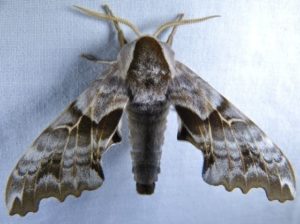One-eyed Sphinx Moth (Smerinthus cerisyi)
The one eyed sphinx moth, a native of North America is a member of the family of hawk moths. English entomologist William Kirby first described this species in 1837 in honor of French entomologist Alexandre Louis Lefèbvre de Cérisy.
en.wikipedia.org
Scientific Classification
- Family: Sphingidae
- Genus: Smerinthus
- Scientific Name: Smerinthus cerisyi
Description and Identification
Caterpillar
The larvae are green with tiny white protrusions. A blue horn can be seen at the rear, and bold white or yellow diagonal lines are observed on both sides of the face. Short diagonal lines run the length of the sides and a thin white line near the ‘spine’.
Adult Moth
Sexual Dimorphism: Present but not prominent.
Color and Appearance
Forewing: When the wings are opened, they are a combination of pale gray and dark brown. When the wings are closed, the outer edge is outlined in a pale brown shade.
Hindwing: When the wings are opened, a blue eyespot is observed, with a black bull’s eye in the middle and a thick black outer ring. When the wings are closed, pink shading surrounding the eyespot is observable.
Average wingspan: 6.2 – 9 cm
Flight Pattern: Erratic
Season: May to August
Egg
Green oval eggs are laid on the leaves of the host plants.
Quick Facts
| Other Names | Cerisy’s sphinx moth |
| Distribution | Newfoundland and Maine west across Michigan, southern Canada to British Columbia and Washington; south to southern California, Baja California Norte, Missouri, Tennessee, and West Texas. |
| Habitat | Streamsides and valleys |
| Lifespan of Adults | Not recorded |
| Host Plants | Poplar and willow |
| Adult Diet | Does not feed |
Scientific Classification
- Family: Sphingidae
- Genus: Smerinthus
- Scientific Name: Smerinthus cerisyi






